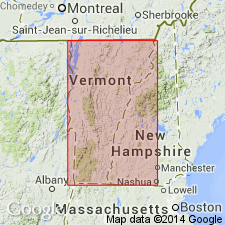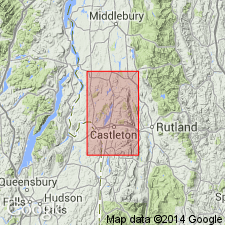
- Usage in publication:
-
- Beebe limestone*
- Modifications:
-
- Original reference
- Dominant lithology:
-
- Limestone
- AAPG geologic province:
-
- New England province
Summary:
Pg. 360, 402. Beebe limestone. This limestone (only 5 to 20 feet thick) would in most other regions be called a member of the slate formation. But here it is such an exceptional change from usual character of the sediments, and so fossiliferous, that it is most important formation of entire Taconic sequence. Named for exposures near Beebe Pond, in Hubbardton, Vermont. Is everywhere present at proper horizon so far as known. Underlies Hooker slate and overlies Bull slate, all of [Early] Cambrian age.
Source: US geologic names lexicon (USGS Bull. 896, p. 143).

- Usage in publication:
-
- Beebe limestone
- Modifications:
-
- Revised
- AAPG geologic province:
-
- New England province
Summary:
Pg. 2. Beebe limestone in West Castleton formation. Massive but discontinuous unit in West Castleton formation (new), in southwestern Vermont. Age is Early Cambrian.
Source: US geologic names lexicon (USGS Bull. 1200, p. 268).

- Usage in publication:
-
- Beebe Limestone Member
- Modifications:
-
- Revised
- AAPG geologic province:
-
- New England province
Summary:
Pg. 304. Beebe Limestone Member of West Castleton Formation. Keith established the Beebe as a separate unit, apparently of formation rank, because within the Taconic sequence it is lithically distinct and faunally significant. The limestone, however, is interbedded with the slate of the West Castleton Formation and is not everywhere present. Therefore it is designated a member of the West Castleton Formation. Age is Early Cambrian (carries the ELLIPTOCEPHALA ASAPHOIDES trilobite fauna).
Source: Taconic stratigraphic names (USGS Bull. 1174, p. 16).
For more information, please contact Nancy Stamm, Geologic Names Committee Secretary.
Asterisk (*) indicates published by U.S. Geological Survey authors.
"No current usage" (†) implies that a name has been abandoned or has fallen into disuse. Former usage and, if known, replacement name given in parentheses ( ).
Slash (/) indicates name conflicts with nomenclatural guidelines (CSN, 1933; ACSN, 1961, 1970; NACSN, 1983, 2005, 2021). May be explained within brackets ([ ]).

